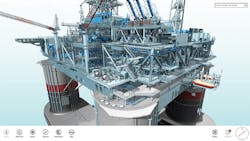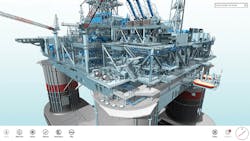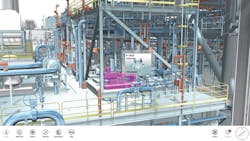Holistic data management can transform operational efficiency
Trond Straume
AVEVA
3D visualization of an offshore platform. (All images courtesy AVEVA)
The offshore industry has embraced the first steps in digitalization. Leading owner-operators and engineering companies are using digital tools to achieve and sustain capital projects excellence and to reduce operating costs. But, few of them have moved to a truly data-centric operating model. And, finding the right partner and the best-fit tools to successfully achieve full digitalization is proving less easy for many companies. They now find themselves at a digitalization crossroads – unsure of the best path to take to achieve true efficiency by embracing digital management tools that can span the asset lifecycle.
A report by AVEVA in partnership with Westwood Global Energy Group found that the industry’s risk-adverse culture coupled with tight budgets and widely-held misconceptions is preventing companies from realizing the full potential of digitalization.
Most senior managers interviewed in the study said they believed digitalization would deliver benefits including reduced operating costs, better quality and sharing of data, and more efficient projects. But few lessons are being shared: companies embarking on digitalization initiatives are often secretive about them, as they provide a significant competitive edge.
One of the stumbling blocks is the misconception that digitalization is primarily about collecting more data. In fact, successful digitalization is about embracing the right tools to help sort vast quantities of information, identifying the relevant data points and linking them logically within an intelligent data system. Successful projects are those that focus on streamlining the use and analysis of both existing and new data to create a single source of truth, and then reorienting your business to allow you to embrace a truly data-centric operating model.
Robust, intelligent data management allows upstream companies to move toward true digitalization of their operations throughout the asset lifecycle. This includes using laser scanning and 3D visualization to create a digital asset, using smart project management tools to improve accountability and contractor management, and integrating engineering and design data with operational information.
Intelligent data management
It does not follow that the more data you have the greater the insights that flow from it. Many companies try to deliver digitalization transformation using their existing IT infrastructure, even though it may not be fit for purpose. This means that they are only able to act as repositories for increased data, which adds little value to their actual operations.
Investing in intelligent data management enables companies to integrate all their data sources into a single source of accurate truth that is easily accessible to all relevant employees and contractors, and that teams can rely on. This reduces human error and clarifies roles and responsibilities.
In times where platform-life is being extended, the risk of unplanned shutdowns and safety incidents is increasing. There is little value in having a system that just flags issues when they arise. A smart system that alerts operators to risks and suggests solutions can reduce the likelihood of an incident and unplanned downtime before it occurs.
To operate effectively and safely, teams must have the capability to have access to and understand the vast amount of data produced. To do this, they need a holistic view - without digital continuity across both the asset and operations lifecycle, it is difficult to capitalize on the opportunities. But, digital continuity requires buy-in from management. The senior team needs to drive integrated digital data management throughout the business cycle, treating data as an asset, just like an offshore platform, an LNG vessel, or a power station.
In this way, digital continuity is also about cultural change, helping to develop and embed data-centric ways of working. And here again, it requires an enterprise-wide approach to build a digitalized culture.
Taking a holistic approach to data throughout the asset lifecycle means capturing and managing consistent data throughout the supply chain.
Once the foundations of data management are in place, companies can start to identify other tools to help them achieve their digitalization goals.
These include:
• Laser scanning and 3D visualization – enabling predictive maintenance and streamlining of capital projects and operations through integrated engineering and design; helping HyperBubble point cloud data to be incorporated into accurate, real-world 3D design
• Intelligent project management systems
• Asset visualization – now that the Cloud, combined with innovative hardware, is enabling teams to view live information blended with historic data, even on site. This includes purpose-built tablets designed for hazardous environments that enable teams to access live data and to make adjustments to the plant from the plant, for the first time.
Creating accurate and as-is 3D visuals of assets improves maintenance planning.
Three factors for successful digitalization
1. Set clear goals for digitalization from the outset that are closely linked to the business vision and objectives. The journey toward true digitalization requires several maturity steps. Being focused on immediate and long-term goals ensures employees and partners stay on track.
2. Create a culture that can embrace digital change and empower the workforce to make digitalization a reality at an operational level. Each digitalization project requires an element of change management, creating an agile organization that is open to change. This requires regular, clear communications and engagement at all levels. Achieving true digitalization takes time and focus as a company’s digital maturity develops.
3. Partner with experts to create a holistic technology ecosystem that supports the asset and operational lifecycle. Most of us have probably experienced the roll-out of a failed IT project at some point and the frustration and wasted time that often results. Joining forces with experts to support projects may require increased upfront investment but will save substantial sums by removing the risk of unexpected disruption during implementation, inexperienced users, and mismatched solutions.
Case study
An offshore liquid natural gas operation was seeking to improve productivity and safety while decreasing downtime and inefficiencies. With 24-hour production generating a myriad of data feeds the facility operators wanted to better use the data to understand and improve performance.
However, they were not able to view the real-time status of the entire facility nor the performance of individual components as part of the overall operation because of the asset’s sheer size, complexity, and regulatory restrictions that prevent the use of certain electronic equipment, including computing devices.
To perform these functions efficiently, facility operators needed a mobile device that was specially certified for Zone 1 areas. It had to be equipped with appropriate software that allowed the team to visualize the entire asset to complete inspections, maintenance, and turnaround projects quickly and efficiently.
AVEVA joined forces with hazardous environment equipment specialist Aegex to provide the Aegex10 Intrinsically Safe Tablet in conjunction with LFM NetView and AVEVA NET software.
It would allow users to:
• Visualize all parts of the asset in 3D and in real time
• Access all relevant information to assess and resolve issues
• Deliver scalable models and immediately share data directly from the worksite via Microsoft Azure Cloud services
• Identify anomalies or specific problem areas of the asset
• Bring appropriate software into hazardous areas of the asset to address problems
• Communicate in real time with teams on and offshore via Skype and email
• Access documentation from inside the most hazardous areas
• Report live status of asset components and share this information with teams.
AVEVA’s LFM NetView provides a web-based 3D laser scan view of an entire industrial asset. Optimized for Google Chrome, it can be accessed online from any location. Microsoft Azure can deliver the laser scan data via the Cloud. LFM NetView also has an offline mode for viewing and manipulating data when outside a Wi-Fi area.
AVEVA NET is a web-based solution for visualizing and collating data and documents of all types. The dashboard provides an interactive, navigable view of 3D models, laser scan data, digital photographs, 2D CAD drawings and ERP data. The software integrates with LFM NetView for high-quality visualization of laser scan data.
Using the Windows-based Aegex10 IS Tablet, operators can enter the most volatile hazardous areas and use all relevant Windows 10 applications. It is rated IP65 rugged for industrial use yet is lightweight and priced as low as non-certified devices. Its operating system gives users uniform access to the Microsoft cloud, plus apps and services.
Having access to critical asset information meant that personnel could address issues in real time. They could share information with the rest of their organization from the site.
Performing these tasks offshore dramatically improved efficiency and saved hundreds of man-hours of work. Rather than completing checklists or reports with pen and paper hours or days later, recording these digitally with tablets featuring visualization software allowed operators to complete work in real time. The operator has transitioned virtually all inspections and reviews of the asset from paper and pen to digital and is rolling out the strategy across other international assets. It estimates that more 483 man-hours will be saved in a year because of the transition. Not only has the flow of information and data between team members improved, but also productivity is estimated to increase by 23% in the first year of implementation.
Conclusion
A change in mind set and culture is required if the upstream sector is to truly embrace digitalization. The onus is on the leaders of operators, engineering companies, and digital providers to work in partnership to not only deliver transformative technology but also to educate and guide their workforces toward successful implementation of innovative tools.
Upstream companies who seek digital continuity throughout the asset lifecycle, who take the time to ensure that they have the right systems in place to collate, manage, analyze, and then visualize their relevant data, will see the biggest growth. •
The author
Trond Straume is chief technology officer at AVEVA. He leads the global technology team in developing engineering and industrial software and pioneering Digital Twin technology. He is leading AVEVA’s SaaS and Cloud services solutions development, including its innovative asset visualization services. Trond holds a degree in computer engineering from Stavanger University in Norway.


